Tamil inscriptions in Sri Lanka date from the centuries before Christ[1] to the modern era. The vast majority of inscriptions date to the centuries following the 10th century AD, and were issued under the reigns of both Tamil and Sinhala rulers alike.[2] Out of the Tamil rulers, almost all surviving inscriptions were issued under the occupying Chola dynasty, whilst one stone inscription and coins of the Jaffna Kingdom have also been found.[3]
Most inscriptions are of a Hindu or Buddhist nature, or record the exploits of merchants, soldiers, officials and kings.
The longest Tamil inscription in the island is from the Lankatilaka Vihara, for which historian K. Indrapala states the following:
"The status of the Tamil language in the Sinhalese kingdom in the pre-colonial period would be an eye-opener to many. Where necessary, Sinhalese kings or other authorities used the Tamil language for their epigraphic records. In the fourteenth century, a record inscribed in Sinhala on the walls of the Lankatilaka Temple was provided with a full Tamil translation on the same walls, as if setting an example to future rulers of the country. This Tamil inscription, incidentally, is the longest Tamil epigraph in the island."[4]
Early Anurādhapura period (300 BC – 300 AD)
Anaikoddai seal, Jaffna
| Background | Translation (English) | Inscription (Tamil in the Brahmi script) |
|---|---|---|
|
A steatite seal from a signet ring found in an early Iron Age burial in Anaikoddai, Jaffna. The seal contains both Brahmi and megalithic graffiti symbols arranged in a way that suggests that they may be a translation of each other.[5] |
|
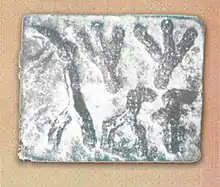 Koveta (read from right to left). |
Tissamaharama coins with Tamil Brahmi legends
| Background | Translation (English) | Inscription (Tamil in the Tamil Brahmi script) |
|---|---|---|
|
Locally produced coins with Tamil Brahmi legends were found in the southern town of Tissamaharama. They are dated to between 200 BC - 200 AD. The coins are thought to have been issued by Tamil traders settled in Sri Lanka.[10] |
|
 Coin 1: Uttiraṉ from Tissamaharama 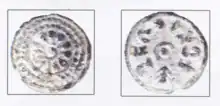 Coin 2: Kapati Katalaṉ from Tissamaharama |
Tamil letters and words in Prakrit inscriptions
| Background | Translation (English) | Inscription (Prakrit with Tamil letters in the Brahmi script) |
|---|---|---|
|
The letters 𑀴, 𑀵, 𑀶 and 𑀷 are unique to Tamil Brahmi. They are found in multiple Tamil words in the earliest Prakrit inscriptions of Sri Lanka.[11][12] The Veḷ name is found several times,[13][14][15] mostly associated with the chief title Parumaka.[16] Parumaka is the single most common lay title in the entire corpus of ancient Brahmi inscriptions, occurring over 314 times. The Tamil kinship term Marumakaṉ which means descendant is also present.[13][12][17] The word Dameḻa (Tamil) is present in six early Prakrit inscriptions related to Buddhist donations and Tamil Buddhist monks. The 𑀟 letter (often reversed) is used here to represent an early form of the Tamil 𑀵 (ḻa).[13][11][18] |
|
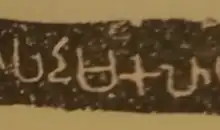 Parumakaḷ 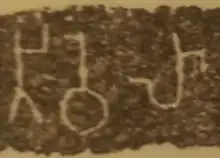 Veḷ 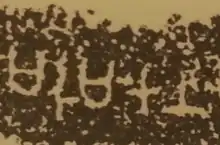 Marumakaṉ 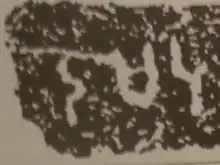 Dameḻa |
(The following Prakrit inscriptions are included for completion as they are related to Tamils)
Tamil house-holder inscription, Anurādhapura
| Background | Translation (English) | Inscription (Prakrit with Tamil letters in the Brahmi script) |
|---|---|---|
|
An inscription referring to a Tamil house-holder terrace made by a Tamil Buddhist monk (samaṇa). |
|
Periya-Puliyankuḷam inscription 1, Vavuniya
| Background | Translation (English) | Inscription (Prakrit in the Brahmi script) |
|---|---|---|
|
Inscription recording a Buddhist donation by a Tamil merchant. |
|
Periya-Puliyankuḷam inscription 2, Vavuniya
| Background | Translation (English) | Inscription (Prakrit in the Brahmi script) |
|---|---|---|
|
Inscription recording a Buddhist donation by a Tamil merchant. |
|
Kuḍuvil inscription, Amparai
| Background | Translation (English) | Inscription (Prakrit in the Brahmi script) |
|---|---|---|
|
Inscription recording a Buddhist donation by a family with a Tamil wife. |
|
Seruwila inscription, Trincomalee
| Background | Translation (English) | Inscription (Prakrit in the Brahmi script) |
|---|---|---|
|
Inscription recording a Buddhist donation by a Tamil devotee.[26]
|
Talagahagoda Vihara inscription, Matale
| Background | Translation (English) | Inscription (Prakrit in the Brahmi script) |
|---|---|---|
|
Inscription mentioning a Tamil Buddhist monk.[27]
|
Ihalagala inscription, Anurādhapura
| Background | Translation (English) | Inscription (Prakrit in the Brahmi script) |
|---|---|---|
|
Inscription recording a Buddhist donation by a Tamil devotee. |
|
Late Anurādhapura period (8th–9th centuries AD)
Abhayagiriya Tamil Buddhist inscription, Anurādhapura
| Background | Translation (English) | Inscription |
|---|---|---|
|
Fragment of a stone slab with Tamil letters inscribed on it found on the platform of the Abhayagiriya. It records an act of merit in the Abhayagiri premises: the construction of the floor or platform of a building occupying an area of 256 square feet and a token gift of money. The letters are dated to the 8th century AD.[29] |
|
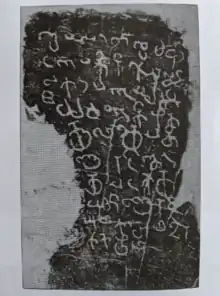 Abhayagiriya Tamil inscription - 8th century AD. |
Ruvanvalisaya Tamil Buddhist inscription, Anurādhapura
| Background | Translation (English) | Inscription |
|---|---|---|
|
Three short Tamil inscriptions found in the premises of the Ruwanwelisaya, Anuradhapura. The inscriptions are found on the pedestals of Dvarapalakas (guardian images). The first inscription dates from the 8th-9th centuries AD. The second dates to the 10th century AD.[30] |
|
Pankuḷiya Tamil Buddhist inscription, Anurādhapura
| Background | Translation (English) | Inscription |
|---|---|---|
|
A short Tamil inscription found at Pankuḷiya Vihara, Anuradhapura recording a donation. It dates to the 9th-10th century AD.[31] |
|
Nānkunāṭṭār Tamil Buddhist Inscription from Anurādhapura
| Background | Translation (English) | Inscription |
|---|---|---|
|
A slab inscription of the Tamil merchant community called the Nānkunāṭṭār. It records an endowment to the Mākkotai Buddhist temple at Anuradhapura. Mākkotai was a prominent town in Kerala and suggests that this temple was started by Tamil Buddhists from Kerala. Dharmapalan was the incumbent monk at this temple. A Sanskrit eulogy to king Sena II of Anuradhapura (866-901 AD) ends the inscription.[32] |
|
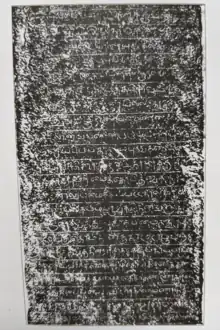 Nānkunāṭṭār Tamil inscription, Anuradhapura - 9th century AD |
Two slab inscriptions from Hindu ruins, Anurādhapura
| Background | Translation (English) | Inscription |
|---|---|---|
|
Two Tamil inscriptions found among the remains of a Hindu temple in Anuradhapura recording endowments. Sri Sanghabodhi is a popular title of medieval Sinhala kings. The text is dated to the late 9th century AD.[33] |
|
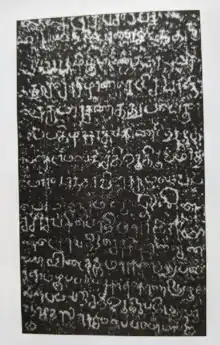 Anuradhapura Hindu ruins slab 1 - 9th century AD 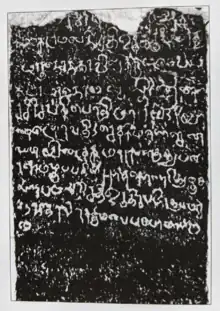 Anuradhapura Hindu ruins slab 2 - 9th century AD |
Chola period (993–1070 AD)
Nilaveli Slab Inscription in the reign of Rajaraja I, Trincomalee
| Background | Translation (English) | Inscription |
|---|---|---|
|
An inscription found in a Ganesh temple in Nilaveli dated to the reign of Rajaraja I before 993 AD. The name 'Tirukōṇamalai' in the inscription remains the Tamil name for Trincomalee to this day.[34] |
|
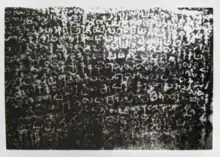 Nilaveli Tamil inscription, 10th century AD |
Koneswaram inscription of Rajaraja I, Trincomalee
| Background | Translation (English) | Inscription |
|---|---|---|
|
Fragmentary inscription from the Koneswaram temple in the reign of Rajaraja I. It is dated to before 993 AD as the eulogy of this king is at an earlier stage of development.[34] |
 Koneswaram inscription of Rajaraja I |
Kielekadawala Siva kovil inscription of Rajaraja I, Trincomalee
| Background | Translation (English) | Inscription |
|---|---|---|
|
A rock inscription found in front of an abandoned Siva temple in an isolated corner of the Kielekadawala village, Gomarankadawala, Trincomalee.[35] |
|
Padaviya inscription of the reign of Rajaraja I
| Background | Translation (English) | Inscription |
|---|---|---|
|
Slab inscription of Rajaraja Chola I found near the Siva temple Ravikulamanikka-isvaram of Padaviya dated to 1005 AD. It records a eulogy to the Chola king and gifts made to the temple by donors.[36] |
|
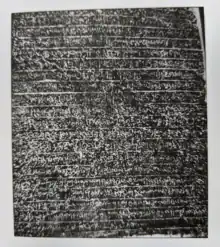 Padaviya inscription of the reign of Rajaraja I - 1005 AD |
Tirukketisvaram inscription in the reign of Rajaraja I, Mannar
| Background | Translation (English) | Inscription |
|---|---|---|
|
An inscription found at Tirukketisvaram in Mannar, Sri Lanka dated to the reign of Rajaraja I (985-1014 AD). It records an endowment to a Hindu temple.[38] |
|
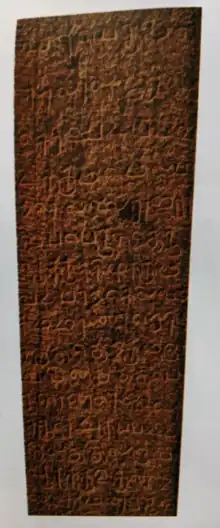 Tirukketisvaram inscription in the reign of Rajaraja I (985-1014 AD) 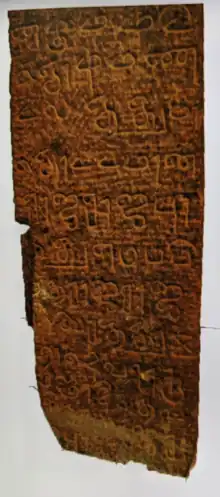 Tirukketisvaram inscription in the reign of Rajaraja I (985-1014 AD) |
Tirukketisvaram inscriptions in the reign of Rajendra Chola I, Mannar
| Background | Translation (English) | Inscription |
|---|---|---|
|
Two fragmentary inscriptions found on a pillar at Tirukketisvaram in Mannar, Sri Lanka dated to the reign of Rajendra Chola I (1014-1044 AD). One inscription contains the initial portion of a eulogy to the king celebrating his conquests. The other records an endowment to a Hindu temple.[39] |
|
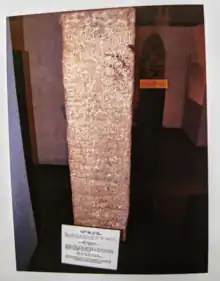 Tirukketisvaram inscriptions of the reign of Rajendra Chola I (1014-1044 AD) 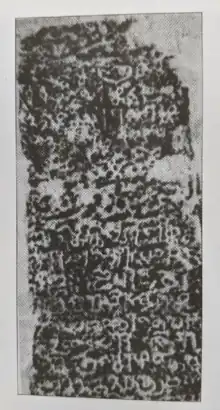 Tirukketisvaram inscriptions of the reign of Rajendra Chola I (1014-1044 AD) |
Pathirakali Amman temple inscription of Rajendra Chola I, Trincomalee
| Background | Translation (English) | Inscription |
|---|---|---|
|
Fragmentary inscription from the Pathirakali Amman Temple, Trincomalee recording an eulogy of Rajendra Chola I. |
|
Slab inscription of Rajendra Chola I from Trincomalee Fort
| Background | Translation (English) | Inscription |
|---|---|---|
|
Slab inscription from Fort Fredrick recording an eulogy of Rajendra Chola I. |
|
Two fragmentary Chola Inscriptions from Kayts Fort, Jaffna
| Background | Translation (English) | Inscription |
|---|---|---|
|
Two fragmentary Chola inscriptions from Kayts fort, Jaffna recording a eulogy to a viceroy of Rajendra Chola I celebrating his conquests.[42] |
|
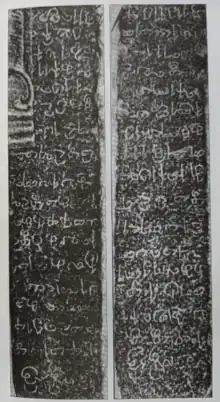 Two fragmentary Chola Inscriptions from Kayts Fort - 11th century AD |
Siva Devale No. 2 inscription, Polonnaruwa
| Background | Translation (English) | Inscription |
|---|---|---|
|
A record of an endowment made to the Siva temple in Pulanari (Tamilised form of Polonnaruwa).[43] |
|
 Siva Devale No.2 Tamil inscription, Polonnaruwa |
Three fragmentary Chola inscriptions from Polonnaruwa
| Background | Translation (English) | Inscription |
|---|---|---|
|
Fragmentary Polonnaruwa inscriptions from the reign of Rajendra Chola I (1014-1044 AD) recording endowments to a temple.[44] |
|
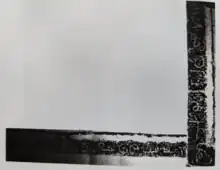 Fragmentary Polonnaruwa Tamil inscriptions |
Three fragmentary Chola inscriptions from Siva Devale No. 2, Polonnaruwa
| Background | Translation (English) | Inscription |
|---|---|---|
|
Fragmentary inscriptions from Polonnaruwa that initially recorded an endowment to the temple 'Vānavanmātēvi - isvaram'. A eulogy to Rajendra Chola I (1014-1044 AD) is also present.[45] |
|
 Tamil inscription 1 from Siva Devale No. 2 - 11th century AD  Tamil inscription 2 from Siva Devale No. 2 - 11th century AD |
Four short inscriptions from Siva Devale No. 1, Padaviya
| Background | Translation (English) | Inscription |
|---|---|---|
|
Inscriptions engraved on stones built into the walls at the temple recording endowments. They are dated to the early 11th century in the reign of Raja Raja Chola I (985-1014 AD).[46] |
|
 Siva Devale No. 1 Tamil inscriptions, Padaviya |
Kantaḷāy Chola Lankeswaran inscription, Trincomalee
| Background | Translation (English) | Inscription |
|---|---|---|
|
Tamil inscription found in Kantaḷāy, Trincomalee District in the reign of Rajendra Chola I (1014-1044 AD). It records a meeting in the Brahmadeya (Brahmin village) when a Chola viceroy Lankeswaran was ruling.[47] |
|
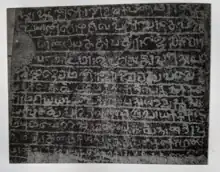 Kantaḷāy Chola Lankeswaran inscription - 11th century AD |
Mānānkēni Chola Lankeswaran inscription, Trincomalee
| Background | Translation (English) | Inscription |
|---|---|---|
|
Tamil inscription found in Mānānkēni, Trincomalee District in the reign of Rajendra Chola I (1014-1044 AD) when a Chola viceroy Lankeswaran was ruling. It refers to constructional activity at the Koneswaram Temple.[48] |
|
Sangilikanadarawa Chola inscription, Anuradhapura
| Background | Translation (English) | Inscription |
|---|---|---|
|
Tamil inscription found in Sangilikanadarawa, Anuradhapura in the reign of Rajendra Chola I (1014-1044 AD). The inscription registers the grant of land and the deposit of some money on interest by a Chola army chief Jayamurinātālavān to a temple.[49] |
|
Diyavinna inscription, Sabaragamuwa
| Background | Translation (English) | Inscription |
|---|---|---|
|
A Tamil inscription found in Diyavinna, Sabaragamuva stating that a person named 'Virabhavanan Dahalabhha Mallam' arrived at this place. His warrior name suggests that he may have been a Chola soldier operating against the Rohana princes in the central highlands. Alternatively, he may just be an adventurer.[49] |
|
Sixteen Tamil Buddhist inscriptions from Velgam Vihara, Trincomalee
| Background | Translation (English) | Inscription |
|---|---|---|
|
16 Tamil inscriptions recording donations by Tamil Buddhists to the ancient Velgam Vehera in Trincomalee District dated to the period of Chola rule (993-1070 AD). Eulogies to the Chola kings are also found here. The temple was renamed and reconstructed as Rajarajapperumpaḷḷi (Great Vihara of Rajaraja I). The base mouldings of this vihara are of Dravidian architecture and differ from other Buddhist edifices in the island. Senarath Paranavithana describes it as the only known example of 'a Tamil Buddhist paḷḷi' preserved up to the present day.[50] |
|
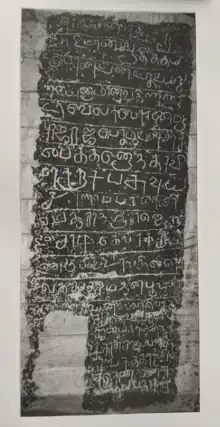 Velgam Vihara Tamil inscription, 11th century AD  Velgam Vihara Tamil inscription, 11th century AD  Velgam Vihara Tamil inscription, 11th century AD Velgam Vihara Tamil inscription, 11th century AD  Velgam Vihara Tamil inscription, 11th century AD  Velgam Vihara Tamil inscription, 11th century AD |
Atakada inscription recording endowment to Saiva Temple
| Background | Translation (English) | Inscription |
|---|---|---|
|
Atakada inscription recording an endowment to a Siva temple of the 11th century AD called Uttamacola isvaram in North Central Province, Sri Lanka.[51] |
|
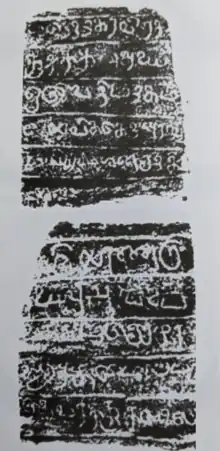 Atakada Tamil inscription, 11th century AD. |
Four pillar inscriptions from Polonnaruwa
| Background | Translation (English) | Inscription |
|---|---|---|
|
Four pillar inscriptions found near Siva Devale. No. 5 recording the names of Chola officials in Polonnaruwa.[52] |
|
 Four pillar inscriptions from Polonnaruva, 11th century AD |
Ainnurruvar Slab inscription from Ataragala, Puttalam
| Background | Translation (English) | Inscription |
|---|---|---|
|
Slab inscription found in Ataragala, Puttalam District recording the construction of a building for Tamil merchants (Ainnurruvar) attached to a Chola military unit in the reign of Rajendra Chola I (1014-1054).[53] |
|
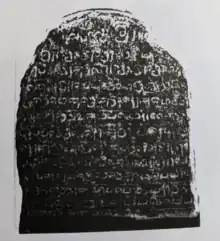 Ataragala Tamil inscription |
Colombo museum Rajendra Chola II inscription
| Background | Translation (English) | Inscription |
|---|---|---|
|
Pillar inscription set up in the reign of Rajendra Chola II (1054-1063 AD). It records the establishment of a Vishnu temple in the southern part of Anuradhapura, and the donations made to it by an agent of the king.[54] |
|
 Colombo museum Rajendra Chola II inscription, 1054-1063 AD |
Medirigiriya Tamil slab inscription, Polonnaruwa
| Background | Translation (English) | Inscription |
|---|---|---|
|
Inscription found in Medirigiriya, Polonnaruwa District dated to 1054 AD in the reign of Rajendra Chola II. It records donations to a Hindu temple in the area.[55] |
|
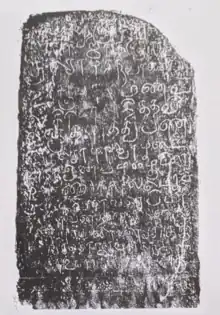 Medigiriya Tamil inscription - 11th century AD |
Vanavanmatevi-isvaram inscription, Polonnaruwa
| Background | Translation (English) | Inscription |
|---|---|---|
|
Inscriptions from the Vanavanmatevi-isvaram, Polonnaruwa in the reign of Athirajendra Chola (1067-1070 AD) recording a eulogy to the king and endowments made to the temple. The administration of the temple is also outlined in this inscription.[56] |
|
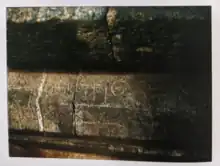 Vanavanmatevi-isvaram inscription, 11th century AD  Vanavanmatevi-isvaram inscription, 11th century AD 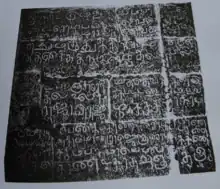 Vanavanmatevi-isvaram inscription, 11th century AD  Vanavanmatevi-isvaram inscription, 11th century AD 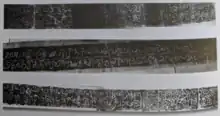 Vanavanmatevi-isvaram inscription, 11th century AD |
Chola inscription from Jaffna Fort
| Background | Translation (English) | Inscription |
|---|---|---|
|
The oldest Tamil stone inscription found in Jaffna. The record was originally set up in a Hindu temple in Nallur, Jaffna between 1018 and 1021 AD in the reign of Rajendra Chola I. The fragmentary inscription records the donation of livestock to the temple by a donor called Cattan.[57] |
|
Chola era Tamil inscriptions from Thirumangalai, Trincomalee
| Background | Translation (English) | Inscription |
|---|---|---|
|
Three Tamil slab inscriptions dating to the Chola era (993-1070 AD), were found in the ruins of a Siva temple in Thirumangalai, Trincomalee District.[58] |
|
Ainnurruvar Polonnaruva Bolappaḷḷi inscription
| Background | Translation (English) | Inscription |
|---|---|---|
|
An 11th century inscription found in the remains of a Saiva temple between the North gate of the medieval city of Polonnaruwa and the Rankot Vihara. It records the close connection Tamil merchants (Ainnurruvar) had with Buddhist shrines (paḷḷi) in the city.[60] |
|
Ainnurruvar Bolappaḷḷi inscription, 11th century AD |
Polonnaruwa period (1070–1215 AD)
Following the expulsion of the Cholas, Vijayabāhu I retained their administrative structure and made significant changes only at the top.[61] The reference to a register of Tamil clerks (Demaḷa lesdaru pota) in Vijayabāhu's Panakaduva Copper Plate inscription points to his employment of Tamil officers in the administration. Possibly many of them continued in service from the time of Chola rule.[61]
Vēḷaikkārar slab inscription of Vijayabahu I, Polonnaruwa
| Background | Translation (English) | Inscription |
|---|---|---|
|
An inscription engraved by Tamil Vēḷaikkārar troops in the 12th century AD celebrating the reign of Vijayabahu I. The Vēḷaikkārar also pledge to protect the Tooth Relic temple.[62] |
|
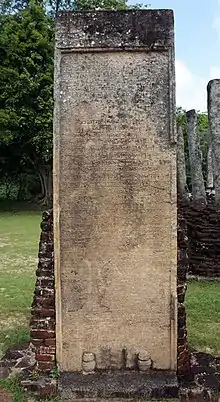 Polonnaruwa inscription of Vijayabahu I - 12th century AD  Polonnaruwa inscription of Vijayabahu I - 12th century AD |
Palamottai slab inscription in the reign of Vijayabahu I, Trincomalee
| Background | Translation (English) | Inscription |
|---|---|---|
|
Slab inscription found among Saiva temple ruins in Palamottai, Kantalai in the Trincomalee District. It records donations made to a Siva temple named after Vijayabahu I.[63] |
|
 Palamottai slab inscription in the reign of Vijayabahu I |
Padaviya Virasasana inscription
| Background | Translation (English) | Inscription |
|---|---|---|
|
Tamil slab inscriptions of the Ainnurruvar merchants based at the merchant town of Padaviya dating to the 12th century AD.[64] |
|
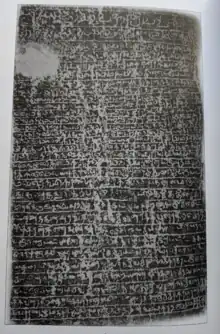 Padaviya Virasasana inscription, 12th century AD |
Kulnoor potters' inscription, Trincomalee
| Background | Translation (English) | Inscription |
|---|---|---|
|
A Tamil slab inscription dating to the 11th-12th century AD, was found in Trincomalee in October 2010. It was found on land on the right side of the Koneswaram Road leading to the Koneswaram temple.[65] |
|
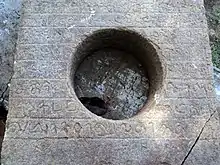 Kulnoor potters' inscription 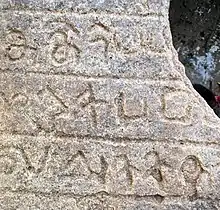 Kulnoor potters' inscription 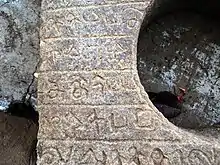 Kulnoor potters' inscription |
Budumuttava Virakkoti inscription
| Background | Translation (English) | Inscription |
|---|---|---|
|
An inscription by the Virakkoti, a merchant military community who the Sinhala Weerakkody are descended from. It records an endowment made to a Buddhist temple maintained by Tamil merchants (Annuruvan-paḷḷi) as well to the deity Paramesvari after they were aided in a skirmish by the council of a merchant town in Magala.[66] |
|
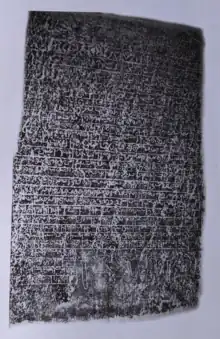 Budumuttava Virakkoti inscription |
Vahalkada slab inscription, Anurādhapura
| Background | Translation (English) | Inscription |
|---|---|---|
|
An inscription found in the Vahalkada tank in the northern part of Anuradhapura District. It records a heroic charter of various Tamil merchant and military communities in a merchant town established in the 11th century AD.[67] |
|
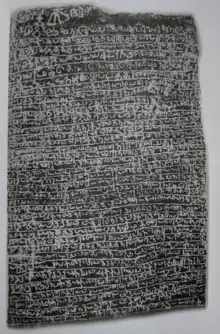 Vahalkada slab inscription, 11th century AD |
Viharehinna merchant inscription, Dambulla
| Background | Translation (English) | Inscription |
|---|---|---|
|
Inscription set up within the premises of Viharehinna temple, Dambulla dating to the 12th century AD. It suggests that the Tamil merchant communities had established a reciprocal relationship with the Buddhist monastic establishment. The name of their merchant town - Tanmacākarap-pattinam - "ocean of dharma", is named after an epithet of the Buddha. The inscription records details pertaining to the Tamil merchants and their military associates.[68] |
|
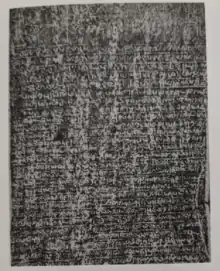 Viharehinna merchant inscription, 12th century AD |
Kodaliparichan inscription of Vēḷaikkārar Mūvēntavēḷān in the years of Jayabahu I, Vavuniya
| Background | Translation (English) | Inscription |
|---|---|---|
|
An inscription found near Mangkulam, Vavuniya District left by Vēḷaikkārar Mūvēntavēḷān dated to the 12th year of Jayabahu I (1122 or 1123 AD).[69] The inscription records the Vēḷaikkārar warriors building a rest house, pond and well in the land granted to them. |
|
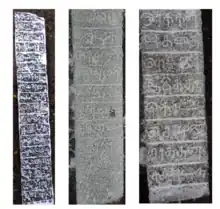 Vavuniya Tamil inscription from 1122 AD |
Kantaḷāy inscription in the years of Jayabahu I, Trincomalee
| Background | Translation (English) | Inscription |
|---|---|---|
|
An inscription found at the Siva temple in Kantaḷāy, Trincomalee District dated to the 35th year of Jayabahu I (1145 AD). It records donations made to the temple by the ruling Gajabahu II, a staunch devotee of Siva. Jayabahu I's successors at Polonnaruwa dated their records in his regal years even after his demise. This is because none of his successors were formally consecrated as rulers til 1153 AD.[70] |
|
Kantaḷāy gal āsana inscription, Trincomalee
| Background | Translation (English) | Inscription |
|---|---|---|
|
A Tamil inscription found in Kantaḷāy, Trincomalee District dating to the 11th or 12th century AD. The inscription is almost completely worn out, but appears to record an endowment by an unknown king.[71] |
|
Mankanay pillar inscription of Gajabahu II, Trincomalee
| Background | Translation (English) | Inscription |
|---|---|---|
|
Pillar inscription from Mankanay, Trincomalee District dated to the 43rd regal year of Jayabahu I (1153 AD). It records a land grant made by Gajabahu II to a Vihara through his Tamil official Mintan Korran who wrote this inscription. An oath is sworn both in the name of the Buddha and Ganesha.[72] |
|
 Mankanay Pillar inscription of Gajabahu II - 12th century AD |
Mayilankulam Vēḷaikkārar inscription in the years of Jayabahu I, Trincomalee
| Background | Translation (English) | Inscription |
|---|---|---|
|
Slab inscription found in Mayilankulam, Trincomalee District dating to the 18th year of Jayabahu I (1128 AD). It was left by Kanavati (Ganapati), the leader of the Vēḷaikkārar army and an agent of the ruling Vikramabahu I (1111–1132 AD). It records a Buddhist temple (perumpaḷḷi/mahavihara) being put under the custody of the Tamil Vēḷaikkārar soldiers.[73] |
|
 Mayilankulam Velaikkarar inscription of Jayabahu I - 12th century AD |
Budumuttava pillar inscriptions in the years of Jayabahu I, Kurunegala
| Background | Translation (English) | Inscription |
|---|---|---|
|
Two pillar inscriptions from Budumuttava, Kurunegala District dating to 1118-9 AD in the regnal years of Jayabahu I. The locality at the time was under the control of Manabharana who is identified in the inscription as Virapperumal, the prince of Pandya lineage. His mother Mitta (the sister to Vijayabahu I, and grandmother of Parakramabahu I) was married to a Pandya prince as recorded in the Culavamsa. Manabharana's consort Cundhamalli was the daughter of Kulottunga I suggesting close and friendly relations with the Cholas in the early years of the 12th century AD. This first inscription records a donation made by her to a Hindu temple. The second inscription records a caste dispute between blacksmiths and washermen being resolved by Manabharana's intervention. It was engraved on the orders of Mākkalingam Kanavati, a Tamil official in the presence of fellow Sinhala officials.[74] |
|
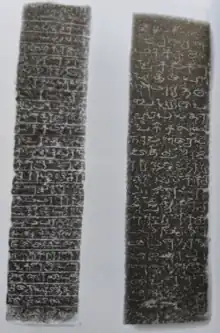 Budumuttava pillar inscriptions of Jayabahu I - 12th century AD |
Puliyankulam pillar inscription of Jayabahu I, Anurādhapura
| Background | Translation (English) | Inscription |
|---|---|---|
|
Tamil Pillar inscription found at Puliyankulam, Anuradhapura District, recording a donation of land to a Buddhist shrine. It is dated to the 12th century AD possibly in the regnal years of Jayabahu I.[75] |
|
Rankot Vihara Velaikkaran inscription of Jayabahu I, Polonnaruwa
| Background | Translation (English) | Inscription |
|---|---|---|
|
Inscription found close to the Rankot Vihara, Polonnaruwa issued by a Tamil warrior chief serving under Jayabahu I.[76] |
|
 Rankot Vihara Velaikkaran inscription of Jayabahu I - 12th century |
Mailawewa Vēḷaikkārar pillar inscription, Trincomalee
| Background | Translation (English) | Inscription |
|---|---|---|
|
Tamil pillar inscription found in Mailawewa, Gomarankadawala, Trincomalee District located close to a Buddhist monastery. |
|
Moragahavela inscription in the reign of Gajabahu II, Polonnaruwa
| Background | Translation (English) | Inscription |
|---|---|---|
|
Pillar inscription at Moragahavela, Tammankaduva dated in the 28th year of Jayabahu I (1138 AD), and in the reign of Gajabahu II. It records a donation of land by a Tamil Vēḷaikkārar soldier to a Buddhist monastery.[77] |
|
 Moragahavela inscription of Gajabahu II - 12th century AD |
Mahakirindegama pillar inscription in the reign of Gajabahu II, Anurādhapura
| Background | Translation (English) | Inscription |
|---|---|---|
|
Pillar inscriptions from Mahakirindegama, Anuradhapura District dating to the reign of Gajabahu II in 1133/4 AD. It records a grant of land and fields to Brahmins of a Hindu temple.[78] |
|
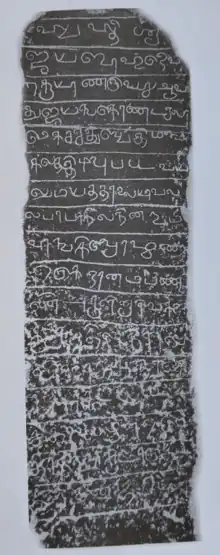 Mahakirindegama pillar inscription of Jayabahu I - 12th century AD |
Hingurakdamana pillar inscription in the reign of Gajabahu II, Polonnaruwa
| Background | Translation (English) | Inscription |
|---|---|---|
|
Pillar inscription from Hingurakdamana, Polonnaruwa District dated to 1150 AD. It records an endowment made to a Buddhist vihara by a Tamil soldier serving under Gajabahu II.[79] |
|
 Hingurakdamana pillar inscription in the reign of Gajabahu II - 12th century AD |
Kantaḷāy pillar inscriptions of Gajabahu II, Trincomalee
| Background | Translation (English) | Inscription |
|---|---|---|
|
Two Tamil pillar inscriptions set up on the order of Gajabahu II as boundary markers in two different localities in Kantaḷāy, Trincomalee District.[80] |
|
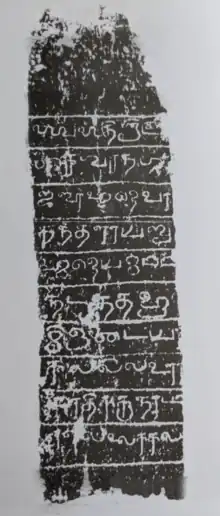 Kantaḷāy pillar inscriptions of Gajabahu II |
Polonnaruwa pillar inscription of Gajabahu II
| Background | Translation (English) | Inscription |
|---|---|---|
|
Fragmentary Tamil inscription recording an endowment made to a Buddhist temple by a Tamil called Atittamahadevan. It dates to 1148 AD in the reign of Gajabahu II.[81] |
|
Galtampitiya Virakkoṭi inscription
| Background | Translation (English) | Inscription |
|---|---|---|
|
Fragmentary inscription left by Virakkoṭi merchants in Galtampitiya. The contents suggests that the Virakkoṭi were worsted in a skirmish and arrested by some foes. They were then released on the intervention of the authorities of the virapaṭṭinam (merchant town). The letters 'Pāṇ' following the word prince suggests a ruler of Pandya lineage such as Manabharana (the cousin of Parakramabahu I) was ruling at the time.[82] |
|
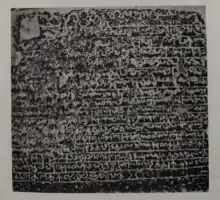 Galtampitiya Virakkoṭi inscription - 12th century AD |
Nainativu Tamil inscription of Parakramabahu I, Jaffna
| Background | Translation (English) | Inscription |
|---|---|---|
|
Parakramabahu I (1153–1186 A.D) issued an edict addressed to his local Tamil officials in Jaffna, advising them on how to deal with shipwrecked foreign traders.[84] |
|
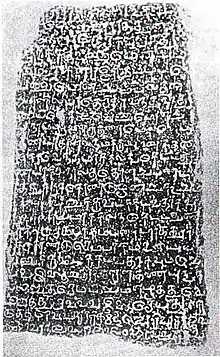 Parakramabahu I (1153–1186 A.D.) Nainativu Tamil inscription |
Panduvasnuvara inscription of Nissanka Malla
| Background | Translation (English) | Inscription |
|---|---|---|
|
Tamil inscription from Panduwasnuwara in the reign of Nissanka Malla (1192 AD), recording his establishment of a Buddhist monastic school (pirivena).[86] |
|
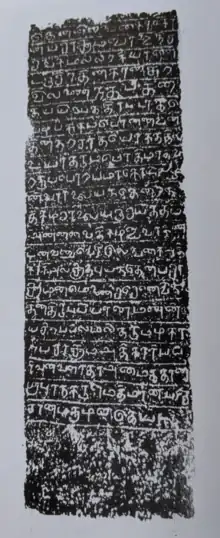 Panduvasnuvara inscription of Nissanka Malla - 12th century AD |
Jetavana Nānādesi bronze image, Anurādhapura
| Background | Translation (English) | Inscription |
|---|---|---|
|
Bronze image of the Nānādesi merchants found in Jetavana, Anuradhapura with a Tamil inscription reading śri nāṇātēciyan dating to the late 12th century AD. Queen Lilavati made an arrangement with the Nānādesi merchants for the maintenance of an alms-hall in Anuradhapura. The same merchants also obtained from the Queen the right to establish and administer a settlement called Madhigaya.[87] |
|
 śri nāṇātēciyan, 12th century AD |
Ridiyegama Nānādesi Bronze seal, Hambantota
| Background | Translation (English) | Inscription |
|---|---|---|
|
A bronze seal of the Nānādesi merchants from Hambantota dating to the 12th century AD.[88] |
|
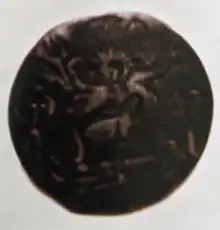 Nanadesi bronze seal, 12th century AD 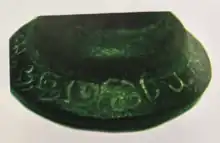 Nanadesi bronze seal, 12th century AD |
Transitional period (1215–1619 AD)
Gomarankadawala rock inscription of Magha, Trincomalee
| Background | Translation (English) | Inscription |
|---|---|---|
|
Tamil inscription from Gomarankadawala, Trincomalee District recording the consecration of Kalinga Magha by a representative of Kulothunga Chola III dating to the early 13th century AD.[89][90] |
|
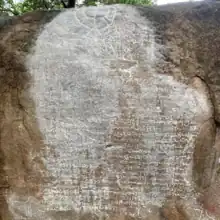 Gomarankadawala inscription of Magha |
Thampalakamam Slab inscription of Magha, Trincomalee
| Background | Translation (English) | Inscription |
|---|---|---|
|
Slab inscription from Thampalakamam, Trincomalee District issued by an official of Kalinga Magha dating to the 13th century AD. It records the conversion of the village into a merchant town.[92] |
|
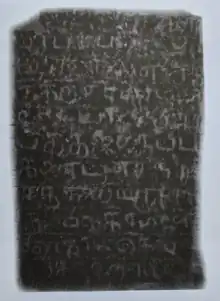 Thampalakamam inscription of Magha, 13th century AD |
Rankot Vihara Vēḷaikkāran Matevan inscription, Polonnaruwa
| Background | Translation (English) | Inscription |
|---|---|---|
|
Late 13th century Tamil inscription found in the premises of Rankot Vihara issued by a Tamil Vēḷaikkārar soldier named Mātēvan. He was appointed a chieftain of a territorial division in Polonnaruwa by Nanti Kirincatan, an invader with connections to the Western Gangas.[93] |
|
 Rankot Vihara Vēḷaikkāran Matevan inscription - 13th century AD |
Villunti Kantucuvami Koyil inscription of Buddhapriya, Trincomalee
| Background | Translation (English) | Inscription |
|---|---|---|
|
A late 13th century inscription from a Skanda temple in Trincomalee left by a Tamil Buddhist agent of the Pandya dynasty. It records the setting up of a pillar of victory at the entrance hall of a temple and is written in both Tamil and Sanskrit.[94] |
|
 Villunti Kantucuvami Koyil inscription of Buddhapriya - 13th century AD |
Welikanda Ainnurruvar slab inscription
| Background | Translation (English) | Inscription |
|---|---|---|
|
An inscription from Welikanda recording the establishment of a Buddhist temple (perumpaḷḷi) by the Ainnurruvar Tamil merchant community. It dates to the 13th century A.D.[95] |
|
 Welikanda Ainnurruvar inscription, 13th century AD |
Dediyamulla Virakkoti slab inscription, Kurunegala
| Background | Translation (English) | Inscription |
|---|---|---|
|
One of the six heroic charters pertaining to the merchant towns established by the Ainnurruvar. Three are from the Kurunegala District. This inscription records a reciprocal agreement between the town council and the Virakkoti, who are also have said to have donated to a Buddhist shrine (lokapperum chettiyar is taken as an appellation of the Buddha.) It dates to the 13th century AD.[96] |
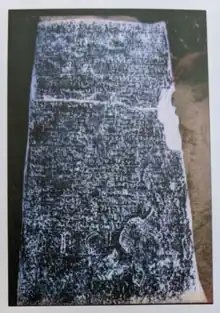 Dediyamulla Virakkoti slab inscription, 13th century AD |
Perilamaiyar inscriptions of Padaviya
| Background | Translation (English) | Inscription |
|---|---|---|
|
Inscriptions from Padaviya issued by the Perilamaiyar, a Tamil agricultural community. They record endowments made to a Hindu temple and are dated to the late 13th century.[97] |
|
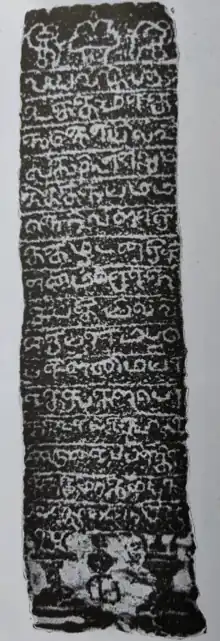 Perilamaiyar inscriptions of Padaviya - 13th century AD |
Fragmentary inscription from Anurādhapura museum
| Background | Translation (English) | Inscription |
|---|---|---|
|
Fragmentary inscription recording an endowment made by a merchant to a Siva temple.[98] |
|
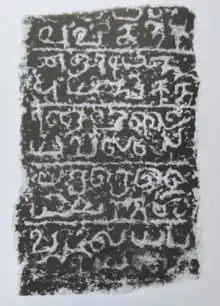 Fragmentary inscription from Anuradhapura museum - 13th century AD |
(The following three Sanskrit inscriptions have been included for completion, as they were issued by Tamils.)
Padaviya Sanskrit bronze seal
| Background | Translation (English) | Inscription |
|---|---|---|
|
Bronze seal issued by a Siva temple in Padaviya dated to the 13th century and inscribed in Grantha script.[99] |
|
 Padaviya Sanskrit bronze seal |
Vēḷaikkārar Sanskrit Buddhist inscription of Padaviya
| Background | Translation (English) | Inscription |
|---|---|---|
|
Sanskrit inscription issued in Padaviya under the reign of the Arya Chakravarti dynasty (Setu family) in the late 13th century. It records a Vihara being built in Padaviya by a Tamil Buddhist general named Lokanatha.[100] |
|
Sanskrit inscription of Codaganga from Trincomalee
| Background | Translation (English) | Inscription |
|---|---|---|
|
Fragmentary Sanskrit inscription from the Koneswaram temple, Trincomalee issued in the name of Codaganga. He is identified with Kulakkottan who is recorded in the chronicles of the temple as also having the name Cholakankan (Codaganga). The inscription is dated to the 13th century AD.[101] |
|
 Sanskrit inscription of Codaganga from Trincomalee - 13th century AD |
Fragmentary inscription from Periyapuliyankulam, Vavuniya
| Background | Translation (English) | Inscription |
|---|---|---|
|
Fragmentary Tamil inscription found in Periyapuliyankulam, Vavuniya District dated to the late 13th century AD.[102] |
|
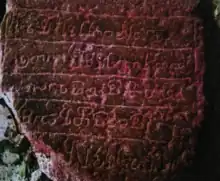 Periyapuliyankulam inscription - 13th century AD |
Kankuveli inscription, Trincomalee
| Background | Translation (English) | Inscription |
|---|---|---|
|
Inscription from Kankuveli village, Trincomalee District dating to the 14th century AD. It records a land grant to the God of Konanāthar by the ruling Vanniyar chieftains and their officers from seven villages. The concluding part of the record mentions Mudalimar, Thānaththār and Varippattu as witnesses to the grant.[103] |
Mehiyalla inscription
| Background | Translation (English) | Inscription |
|---|---|---|
Kotagama slab inscription of Arya Chakravarti, Kegalle
| Background | Translation (English) | Inscription |
|---|---|---|
|
The Kotagama inscription found in Kegalle District is a record of victory left by the Aryacakravarti dynasty of the Jaffna Kingdom in western Sri Lanka (14th century AD). 'Anurai' is derived from Anuradhapura and is a term used to describe all capitals of the Sinhala kingdom.[104] |
|
 Kotagama inscription as displayed in the National Museum of Colombo, Sri Lanka in December 2011  Kotagama Tamil inscription - 14th century AD |
Lankatilaka Vihara inscription of Bhuvanaikabahu IV
| Background | Translation (English) | Inscription |
|---|---|---|
|
In the 14th century, a record inscribed in Sinhala on the walls of the Lankatilaka Vihara was provided with a full Tamil translation on the same walls. It is the longest of all Tamil inscriptions found in Sri Lanka and was issued in the reign of Bhuvanaikabahu IV of Gampola (1344-1354 AD). Both inscriptions register the grant of extensive fields and donations to the Buddhist shrine.[106] |
|
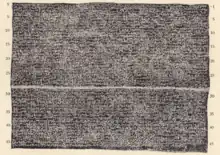 Lankatilaka Vihara inscription of Bhuvanaikabahu IV - 14th century AD |
Galle trilingual inscription of Zheng He
| Background | Translation (English) | Inscription |
|---|---|---|
|
A stone tablet with an inscription in three languages, Chinese, Tamil and Persian. It is dated to 15 February 1409 and was installed by the Chinese admiral Zheng He in Galle during his grand voyages. The Tamil inscription records an endowment made to the Vishnu temple of Dondra (Lord Tenavarai Nayanar).[107] |
|
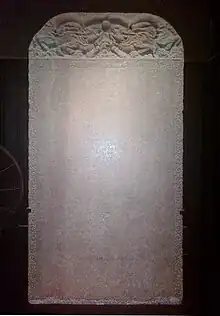 Galle trilingual inscription, 1409 AD |
Thirukkovil pillar inscription, Amparai
| Background | Translation (English) | Inscription |
|---|---|---|
Munnesvaram inscription of Parakramabahu VI
| Background | Translation (English) | Inscription |
|---|---|---|
|
Munneswaram temple inscription recording a grant of land and money to the temple and priests by King Parakramabahu VI (1412-1467 AD).[108] |
|
 Munneswaram inscription of Parakramabahu VI (1412-1467 AD) |
Fragmentary Jaffna inscription of Parakramabahu VI
| Background | Translation (English) | Inscription |
|---|---|---|
|
Fragmentary Tamil inscription of Parakramabahu VI (1410-1467 AD) in Jaffna. His adopted son Sapumal Kumaraya had conquered the Jaffna Kingdom in 1450 AD and ruled it as a vassal state for 17 years. His name is still mentioned in prayers at the Nallur Kandaswamy Temple which he rebuilt.[109] |
|
Naimmana inscription of Parakramabahu VI, Matara
| Background | Translation (English) | Inscription |
|---|---|---|
|
Tamil inscription of Parakramabahu VI found in Naimmana village, Matara District. It records a grant of fields in Naimmana to feed Brahmins at the alms hall near the shrine of Devinuwara. It is dated to 1433 AD.[110] |
|
Kalutara pillar inscription
| Background | Translation (English) | Inscription |
|---|---|---|
|
Pillar inscription found in Kalutara dating to the 15th century AD. It records an endowment to a Kali temple.[112] |
Kankuveli Agasthi Stapana Kovil inscription, Trincomalee
| Background | Translation (English) | Inscription |
|---|---|---|
|
Pillar inscription recording a grant to the Kankuveli Agasthi Stapana kovil dating to the 15th century AD.[35]
|
Tamil pillar inscription in the reign of Vijayabahu VI
| Background | Translation (English) | Inscription |
|---|---|---|
|
Pillar inscription issued by Vijayabahu VI of Kotte in 1517 AD. It records the construction of a Kantacuvami temple by an Accutan Nayan.[113] |
Thambiluvil inscription of Vijayabahu VI, Amparai
| Background | Translation (English) | Inscription |
|---|---|---|
|
Thambiluvil Inscription issued by Vijayabahu VI (1513-1521 AD) recording his endowment of vōvil to a Siva temple in Thambiluvil, Amparai District.[103] |
|
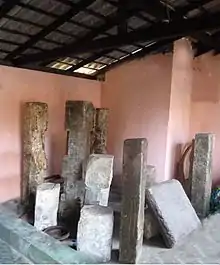 Thambiluvil Inscription along with other inscriptions kept now in Thirukkovil Temple |
Coins of the Jaffna Kingdom
| Background | Translation (English) | Inscription |
|---|---|---|
|
Coins issued by the Aryacakravarti dynasty of the Jaffna Kingdom (1215-1619 AD) with legends reading 'Setu'. The dynasty claimed to be protectors of the Setu and claimed lineage from the Tamil Brahmins of the prominent Hindu temple of Rameswaram.[114] |
|
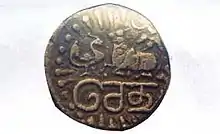 Setu coin 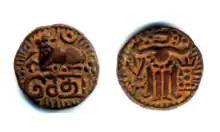 Setu coin |
Trincomalee Fort Koneswaram inscription
| Background | Translation (English) | Inscription |
|---|---|---|
|
An inscription dating from the 16th century prophesying the destruction of the Koneswaram Temple at the hands of the Portuguese. The temple was subsequently destroyed on 14 April 1622. The pair of fishes on the inscription likely date to the 13th century, when the Pandya dynasty had conquered Trincomalee.[115] |
|
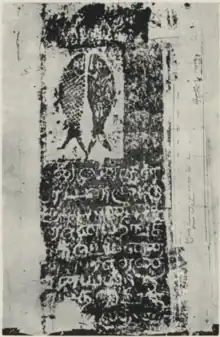 Fort Frederick Koneswaram inscription |
Tamil inscriptions from Thirumangalai, Trincomalee
| Background | Translation (English) | Inscription |
|---|---|---|
|
Two Tamil slab inscriptions dating to the 15th and 16th century, were found in the ruins of a Siva temple in Thirumangalai, Trincomalee District.[59] |
|
Late Kandyan period (1619 - 1815 AD)
Thirumangalai Temple Bell inscription, Trincomalee
| Background | Translation (English) | Inscription |
|---|---|---|
|
A bell belonging to the Thirumangalai temple was found in Kankuveli, Trincomalee District. An inscription on it dating to the 17th century shows that the temple was under worship for more than 700 years.[59] |
|
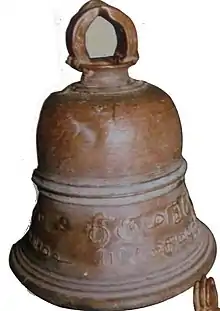 Thirumangalai Temple Bell |
Tamil conch inscription
| Background | Translation (English) | Inscription |
|---|---|---|
|
Valampuri conch with bronze attachments. There are figures of a Shiva linga, Nandi and peacock on the conch and a Tamil inscription dated paleographically to the 16th or 17th century AD.[116]
|
|
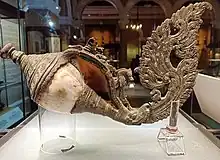 Valampuri conch with Tamil inscription |
Veeramunai Copper plates in the reign of Senarat, Amparai
| Background | Translation (English) | Inscription |
|---|---|---|
|
Tamil copper plate grants found in Veeramunai, Amparai District. They record a visit of Chetty traders from Madurai with an idol of Ganesh and a royal princess. It is dated to the reign of King Senarat in the 17th century AD.[103] |
Sammanthurai Copper plates in the reign of Rajasinghe II, Amparai
| Background | Translation (English) | Inscription |
|---|---|---|
|
Tamil copper plate grants to a Brahmin called Ramanathan found in Sammanthurai, Amparai District. It is dated to the reign of Rajasinghe II in the 17th century AD.[103] |
Verugal Copper Plates of the Vanniyar, Trincomalee
| Background | Translation (English) | Inscription |
|---|---|---|
|
Inscription found in Verugal, Trincomalee District dating to 1722 AD. It records the names of persons who built the four walls of a temple, including Kayilaya-vanniyanar (a ruling Vanniyar chieftain) and Timassa, the son of Simayapillai.[103] |
References
- ↑ Mahadevan, I. (2014). Early Tamil Epigraphy - From the Earliest Times to the Sixth century C.E., 2nd Edition. pp. 44, 65.
- ↑ Pathmanathan, S. (2019). Tamil inscriptions in Sri Lanka - Volume 1. Kumaran Book House. ISBN 978-624-5015-07-8. p. xxiv-xxvii, p. xiii
- ↑ Pathmanathan, S. (1978). The Kingdom of Jaffna. p. 241-243
- ↑ Indrapala, K. (2005). The Evolution of an Ethnic Identity - The Tamils of Sri Lanka 300 B.C.E to 1200 C.E. ISBN 0-646-42546-3. p. 282
- ↑ Ragupathy, Ponnampalam. Early settlements in Jaffna. (1987) p. 119-204
- ↑ Indrapala, K. (2005). The Evolution of an Ethnic Identity - The Tamils of Sri Lanka 300 B.C.E to 1200 C.E. ISBN 0-646-42546-3. p. 324-325
- ↑ Frontline, Reading the past in a more inclusive way - Interview with Dr. Sudharshan Seneviratne. (2006) https://frontline.thehindu.com/other/article30208096.ece
- ↑ Seneviratne, Sudharshan. (1992). Pre-State Chieftains And Servants of the State: A Case Study of Parumaka. p. 108 http://dlib.pdn.ac.lk/handle/123456789/2078
- ↑ Bopearachchi, Osmund. Graffiti Marks of Kodumanal (India) and Ridiyagama (Sri Lanka) — A Comparative Study (2002) p. 100
- 1 2 Bopearachchi, Osmund (2008). Tamil traders in Sri Lanka and Sinhala traders in Tamil Nadu. p. 18-21
- 1 2 Karunaratne, S (1984). Epigraphia Zeylanica (EZ) VII. p. 32-35
- 1 2 Pushparatnam, P. (2014). "Tamil Brahmi Inscription Belonging to 2200 years ago, Discovered by German Archaeological Team in Southern Sri Lanka". Proceedings of Jaffna University International Research Conference 2014.p. 544
- 1 2 3 Mahadevan, I. (2014). Early Tamil Epigraphy - From the Earliest Times to the Sixth century C.E., 2nd Edition. pp. 229–231.
- ↑ Sitrampalam, S.K. (1990). The Velu of Sri Lankan Brahmi Inscriptions, A Reappraisal, Perspectives in Archaeology. p. 89-94
- ↑ Dravidian Etymology Dictionary entry 5545, https://dsal.uchicago.edu/cgi-bin/app/burrow_query.py?page=506
- 1 2 Seneviratne, Sudharshan. (1992). Pre-State Chieftains And Servants of the State: A Case Study of Parumaka. p. 99-130
- ↑ Dravidian Etymology Dictionary Entry 4715, https://dsal.uchicago.edu/cgi-bin/app/burrow_query.py?page=417
- ↑ Senanayake, A.M.P. (2017). "A STUDY ON SOCIAL IDENTITY BASED ON THE BRAHMI INSCRIPTIONS OF THE EARLY HISTORIC PERIOD IN THE NORTH WESTERN PROVINCE, SRI LANKA" (PDF). Social Affairs: A Journal for the Social Sciences. 1 (6): 38.
- ↑ University of Madras Tamil Lexicon, p.2881, https://dsal.uchicago.edu/cgi-bin/app/tamil-lex_query.py?qs=பெருமகன்&searchhws=yes&matchtype=exact
- ↑ Harry Falk, Owner's Graffiti on pottery from Tissamaharama (2014), https://www.academia.edu/11754083/Owners_graffiti_on_pottery_from_Tissamaharama p.74
- ↑ Yan Oya Middle Basin Mortuary Archaeology Research Project (2013), Donor's evidence https://web.archive.org/web/20160321113718/http://yanoyaarchaeology.com/index.html
- ↑ Paranavitana, Senarath (1970). "Inscriptions of Ceylon - Volume I, Inscription no. 94". inscriptions.lk. Retrieved 14 December 2023.
- ↑ Paranavitana, Senarath (1970). "Inscriptions of Ceylon - Volume I, Inscription no. 356". inscriptions.lk. Retrieved 14 December 2023.
- ↑ Paranavitana, Senarath (1970). "Inscriptions of Ceylon - Volume I, Inscription no. 357". inscriptions.lk. Retrieved 14 December 2023.
- ↑ Paranavitana, Senarath (1970). "Inscriptions of Ceylon - Volume I, Inscription no. 480". inscriptions.lk. Retrieved 14 December 2023.
- ↑ Paranavitana, Senarath (1974). Epigraphical Notes 1974: 13.4. Sri Lanka: Department of Archaeology.
- ↑ Sumanajothi, P. & S. S. Wijesooriya. (1984). Ancient Temples in Matale District. In Historical Matale (pp. 97-130). Matale: The Cultural Board of Matale District
- ↑ Paranavitana, Senarath (1970). "Inscriptions of Ceylon - Volume II, Part II, Inscription no. 142(B)". inscriptions.lk. Retrieved 14 December 2023.
- 1 2 Pathmanathan, S. (2019). Tamil inscriptions in Sri Lanka - Volume 1. Kumaran Book House. ISBN 978-624-5015-07-8. p. 102-107.
- 1 2 Pathmanathan, S. (2019). Tamil inscriptions in Sri Lanka - Volume 1. Kumaran Book House. ISBN 978-624-5015-07-8. p. 108-112.
- 1 2 Pathmanathan, S. (2019). Tamil inscriptions in Sri Lanka - Volume 1. Kumaran Book House. ISBN 978-624-5015-07-8. p. 111.
- 1 2 Pathmanathan, S. (2019). Tamil inscriptions in Sri Lanka - Volume 1. Kumaran Book House. ISBN 978-624-5015-07-8. p. 113-123.
- 1 2 Pathmanathan, S. (2019). Tamil inscriptions in Sri Lanka - Volume 1. Kumaran Book House. ISBN 978-624-5015-07-8. p. 124-129.
- 1 2 3 Pathmanathan, S. (2019). Tamil inscriptions in Sri Lanka - Volume 1. Kumaran Book House. ISBN 978-624-5015-07-8. p. 133-140.
- 1 2 3 4 5 Thantilage, A. (2016). Five Tamil inscriptions of the Trincomalee district : discoveries during the PGIAR ancient copper metallugy project at Seruwila. pp. 1–5.
- ↑ Pathmanathan, S. (2019). Tamil inscriptions in Sri Lanka - Volume 1. Kumaran Book House. ISBN 978-624-5015-07-8. p. 141-145.
- ↑ Indrapala, K. (1971). Epigraphia Tamilica: A journal of Tamil Epigraphy. Jaffna Archaeological Society. p. 35.
- 1 2 Pathmanathan, S. (2019). Tamil inscriptions in Sri Lanka - Volume 1. Kumaran Book House. ISBN 978-624-5015-07-8. p. 146-165.
- 1 2 Pathmanathan, S. (2019). Tamil inscriptions in Sri Lanka - Volume 1. Kumaran Book House. ISBN 978-624-5015-07-8. p. 166-177.
- ↑ Gunasingam, S. (1979). Three Cola Inscriptions from Trincomalee. p. 11.
- ↑ Gunasingam, S. (1979). Three Cola Inscriptions from Trincomalee. p. 20.
- 1 2 Pathmanathan, S. (2019). Tamil inscriptions in Sri Lanka - Volume 1. Kumaran Book House. ISBN 978-624-5015-07-8. p. 178-185.
- 1 2 Pathmanathan, S. (2019). Tamil inscriptions in Sri Lanka - Volume 1. Kumaran Book House. ISBN 978-624-5015-07-8. p. 186-189.
- 1 2 Pathmanathan, S. (2019). Tamil inscriptions in Sri Lanka - Volume 1. Kumaran Book House. ISBN 978-624-5015-07-8. p. 190-194.
- 1 2 Pathmanathan, S. (2019). Tamil inscriptions in Sri Lanka - Volume 1. Kumaran Book House. ISBN 978-624-5015-07-8. p. 195-198.
- 1 2 Pathmanathan, S. (2019). Tamil inscriptions in Sri Lanka - Volume 1. Kumaran Book House. ISBN 978-624-5015-07-8. p. 199-203.
- 1 2 Pathmanathan, S. (2019). Tamil inscriptions in Sri Lanka - Volume 1. Kumaran Book House. ISBN 978-624-5015-07-8. p. 204-217.
- ↑ Gunasingam, S. (1974). Two inscriptions of Cola Ilankesvara Deva. Peradeniya : Akurana Printers. p. 1-22
- 1 2 Indrapala, K. (1965). Dravidian settlements in Ceylon and the beginnings of the kingdom of Jaffna. PhD thesis. University of London. p.107-109
- 1 2 Pathmanathan, S. (2019). Tamil inscriptions in Sri Lanka - Volume 1. Kumaran Book House. ISBN 978-624-5015-07-8. p. 218-240.
- 1 2 Pathmanathan, S. (2019). Tamil inscriptions in Sri Lanka - Volume 1. Kumaran Book House. ISBN 978-624-5015-07-8. p. 241-244.
- 1 2 Pathmanathan, S. (2019). Tamil inscriptions in Sri Lanka - Volume 1. Kumaran Book House. ISBN 978-624-5015-07-8. p. 245-250.
- 1 2 Pathmanathan, S. (2019). Tamil inscriptions in Sri Lanka - Volume 1. Kumaran Book House. ISBN 978-624-5015-07-8. p. 251-264.
- 1 2 Pathmanathan, S. (2019). Tamil inscriptions in Sri Lanka - Volume 1. Kumaran Book House. ISBN 978-624-5015-07-8. p. 265-288.
- 1 2 Pathmanathan, S. (2019). Tamil inscriptions in Sri Lanka - Volume 1. Kumaran Book House. ISBN 978-624-5015-07-8. p. 289-293.
- 1 2 Pathmanathan, S. (2019). Tamil inscriptions in Sri Lanka - Volume 1. Kumaran Book House. ISBN 978-624-5015-07-8. p. 294-306.
- 1 2 Indrapala, K. (1971). Epigraphia Tamilica: A journal of Tamil Epigraphy. Jaffna Archaeological Society. pp. 52–64.
- ↑ 1000 years old tamil epigraphs found in the ruins of Sivan temple located in jungles of Trincomalee.(2017)
- 1 2 3 4 5 Pushparatnam, P (2021). "Recently Discovered Ruins of Civaṉ Temple with Tamil Inscriptions at Tirumańkalᾱi Area in Trincomalai District, Sri Lanka" (PDF). Journal of Jaffna Science Association. 3 (1): 24–31.
- 1 2 Pathmanathan, S. (2019). Tamil inscriptions in Sri Lanka - Volume 1. Kumaran Book House. ISBN 978-624-5015-07-8. p. 347-350.
- 1 2 Indrapala, K. (2005). The Evolution of an Ethnic Identity - The Tamils of Sri Lanka 300 B.C.E to 1200 C.E. ISBN 0-646-42546-3. p. 251
- 1 2 Pathmanathan, S. (2019). Tamil inscriptions in Sri Lanka - Volume 1. Kumaran Book House. ISBN 978-624-5015-07-8. p. 455-482.
- 1 2 Pathmanathan, S. (2019). Tamil inscriptions in Sri Lanka - Volume 1. Kumaran Book House. ISBN 978-624-5015-07-8. p. 309-320.
- 1 2 Pathmanathan, S. (2019). Tamil inscriptions in Sri Lanka - Volume 1. Kumaran Book House. ISBN 978-624-5015-07-8. p. 393-411.
- ↑ Millennium old Tamil inscription found in Trincomalee. (2010)
- 1 2 Pathmanathan, S. (2019). Tamil inscriptions in Sri Lanka - Volume 1. Kumaran Book House. ISBN 978-624-5015-07-8. p. 351-371.
- 1 2 Pathmanathan, S. (2019). Tamil inscriptions in Sri Lanka - Volume 1. Kumaran Book House. ISBN 978-624-5015-07-8. p. 372-392.
- 1 2 Pathmanathan, S. (2019). Tamil inscriptions in Sri Lanka - Volume 1. Kumaran Book House. ISBN 978-624-5015-07-8. p. 412-427.
- ↑ K. Indrapala, வன்னியில் மூவேந்த வேளானும் வேளைக்காறப் படையினரும், Tamil Mirror, 21 February 2023, p.5
- 1 2 Pathmanathan, S. (2019). Tamil inscriptions in Sri Lanka - Volume 1. Kumaran Book House. ISBN 978-624-5015-07-8. p. 328-334.
- 1 2 Veluppillai, A. (1971). Ceylon Tamil Inscriptions: Volume 1. Peradeniya. pp. 38–41.
- 1 2 Pathmanathan, S. (2019). Tamil inscriptions in Sri Lanka - Volume 1. Kumaran Book House. ISBN 978-624-5015-07-8. p. 562-578.
- 1 2 Pathmanathan, S. (2019). Tamil inscriptions in Sri Lanka - Volume 1. Kumaran Book House. ISBN 978-624-5015-07-8. p. 489-494.
- 1 2 Pathmanathan, S. (2019). Tamil inscriptions in Sri Lanka - Volume 1. Kumaran Book House. ISBN 978-624-5015-07-8. p. 546-561.
- 1 2 Pathmanathan, S. (2019). Tamil inscriptions in Sri Lanka - Volume 1. Kumaran Book House. ISBN 978-624-5015-07-8. p. 625-628.
- 1 2 Pathmanathan, S. (2019). Tamil inscriptions in Sri Lanka - Volume 1. Kumaran Book House. ISBN 978-624-5015-07-8. p. 483-488.
- 1 2 Pathmanathan, S. (2019). Tamil inscriptions in Sri Lanka - Volume 1. Kumaran Book House. ISBN 978-624-5015-07-8. p. 529-536.
- 1 2 Pathmanathan, S. (2019). Tamil inscriptions in Sri Lanka - Volume 1. Kumaran Book House. ISBN 978-624-5015-07-8. p. 335-344.
- 1 2 Pathmanathan, S. (2019). Tamil inscriptions in Sri Lanka - Volume 1. Kumaran Book House. ISBN 978-624-5015-07-8. p. 519-524.
- 1 2 Pathmanathan, S. (2019). Tamil inscriptions in Sri Lanka - Volume 1. Kumaran Book House. ISBN 978-624-5015-07-8. p. 321-327.
- 1 2 Pathmanathan, S. (2019). Tamil inscriptions in Sri Lanka - Volume 1. Kumaran Book House. ISBN 978-624-5015-07-8. p. 539-545.
- ↑ Pathmanathan, S. (2019). Tamil inscriptions in Sri Lanka - Volume 1. Kumaran Book House. ISBN 978-624-5015-07-8. p. 428-430.
- ↑ Veluppillai, A. (1971). Ceylon Tamil Inscriptions: Volume 1. Peradeniya. p. 14.
- ↑ Indrapala, K. (1965). Dravidian settlements in Ceylon and the beginnings of the kingdom of Jaffna, pp. 230–231
- ↑ Indrapala, K. (1963). University of Ceylon Review - The Nainativu Tamil Inscription of Parakramababhu I. pp. 63–70.
- 1 2 Pathmanathan, S. (2019). Tamil inscriptions in Sri Lanka - Volume 1. Kumaran Book House. ISBN 978-624-5015-07-8. p. 587-603.
- 1 2 Pathmanathan, S. (2019). Tamil inscriptions in Sri Lanka - Volume 1. Kumaran Book House. ISBN 978-624-5015-07-8. p. 438-440.
- 1 2 Pathmanathan, S. (2019). Tamil inscriptions in Sri Lanka - Volume 1. Kumaran Book House. ISBN 978-624-5015-07-8. p. 441-448.
- ↑ Professor P. Pusparatnam, Rare Tamil inscription found in Trincomalee (2021) https://vanakkamlondon.com/stories/research-stories/2021/11/139704/
- ↑ "இலங்கை தமிழர் வரலாறு: புதிய தகவல்களைக் கூறும் 13ஆம் நூற்றாண்டு கல்வெட்டு". BBC News தமிழ்.
- ↑ K. Indrapala, A newly discovered inscription relating to Magha's invasion, Sasanam journal, Volume 6, 2022, Krishnagiri
- 1 2 Pathmanathan, S. (2019). Tamil inscriptions in Sri Lanka - Volume 1. Kumaran Book House. ISBN 978-624-5015-07-8. p. 449-453.
- 1 2 Pathmanathan, S. (2019). Tamil inscriptions in Sri Lanka - Volume 1. Kumaran Book House. ISBN 978-624-5015-07-8. p. 495-503.
- 1 2 Pathmanathan, S. (2019). Tamil inscriptions in Sri Lanka - Volume 1. Kumaran Book House. ISBN 978-624-5015-07-8. p. 604-610.
- 1 2 Pathmanathan, S. (2019). Tamil inscriptions in Sri Lanka - Volume 1. Kumaran Book House. ISBN 978-624-5015-07-8. p. 436-437.
- ↑ Pathmanathan, S. (2019). Tamil inscriptions in Sri Lanka - Volume 1. Kumaran Book House. ISBN 978-624-5015-07-8. p. 431-435.
- 1 2 Pathmanathan, S. (2019). Tamil inscriptions in Sri Lanka - Volume 1. Kumaran Book House. ISBN 978-624-5015-07-8. p. 611-621.
- 1 2 Pathmanathan, S. (2019). Tamil inscriptions in Sri Lanka - Volume 1. Kumaran Book House. ISBN 978-624-5015-07-8. p. 623-624.
- 1 2 Pathmanathan, S. (2019). Tamil inscriptions in Sri Lanka - Volume 1. Kumaran Book House. ISBN 978-624-5015-07-8. p. 622.
- 1 2 Pathmanathan, S. (2019). Tamil inscriptions in Sri Lanka - Volume 1. Kumaran Book House. ISBN 978-624-5015-07-8. p. 504-518.
- 1 2 Pathmanathan, S. (2019). Tamil inscriptions in Sri Lanka - Volume 1. Kumaran Book House. ISBN 978-624-5015-07-8. p. 629-638.
- 1 2 Pathmanathan, S. (2019). Tamil inscriptions in Sri Lanka - Volume 1. Kumaran Book House. ISBN 978-624-5015-07-8. p. 525-528.
- 1 2 3 4 5 Indrapala, K. (1968). Cintanai Volume 2. Peradeniya. pp. 37–40.
- ↑ Pathmanathan, S. (2010). Tamil inscriptions in the Colombo National Museum: Spolia Zeylanica. Vol 47. pp. 69–74.
- ↑ Rasanayagam, C. (1926). Ancient Jaffna. p. 364.
- 1 2 Pathmanathan, S. (1974). The Munnesvaram Tamil Inscription of Parākramabāhu VI. p. 54-69
- 1 2 Pathmanathan, S. (1978). The Kingdom of Jaffna. p. 272-275
- ↑ Pathmanathan, S. (2010). Tamil inscriptions in the Colombo National Museum: Spolia Zeylanica. Vol 47. pp. 39–52.
- ↑ Veluppillai, A. (1971). Ceylon Tamil Inscriptions: Volume 1. Peradeniya. pp. 66–67.
- ↑ Veluppillai, A. (1971). Ceylon Tamil Inscriptions: Volume 1. Peradeniya. pp. 44–45.
- ↑ Pathmanathan, S. (2010). Tamil inscriptions in the Colombo National Museum: Spolia Zeylanica. Vol 47. pp. 75–78.
- 1 2 Pathmanathan, S. (1978). The Kingdom of Jaffna. p. 181
- 1 2 Codrington, H. W. (1927). The Inscription at Fort Frederick, Trincomalee. pp. 448–451.
- 1 2 Pathmanathan, S. (2005). Tamil inscriptions in the Colombo National Museum. Colombo Department of national museums. pp. 79–85. ISBN 978-955-5780-27-8.